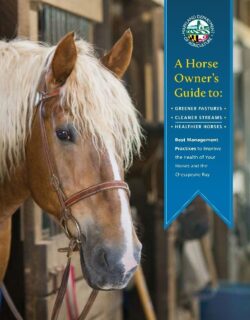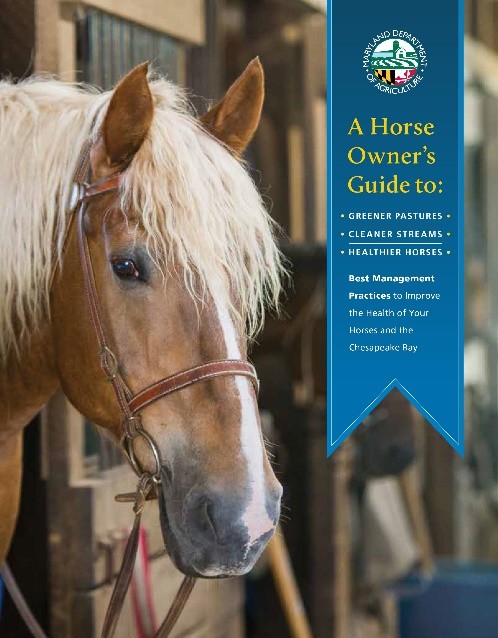Maryland Horse Farms for Healthy Horses and a Clean Environment
By Jane Thery for ELCR
Summary
The Maryland Horse Industry Board with the Maryland Department of Agriculture and the Soil Conservation Districts offer technical and financial support to horse farms regarding healthy pastures and clean water. This article aims to share the Maryland experience across the national horse community.
The overall recommendations to motivate government-funded programs in Maryland to support horse farms with high environmental standards are:
- Make strategic alliances with important agriculture and environment groups inside and outside of government to get attention and resource allocation to horse farms.
- Establish data on the importance of horse farms in environmental land management.
- Encourage members of the horse community to attend meetings where agricultural and environmental issues are discussed and to speak up.
- Celebrate successes and show off best practices on horse farms.
- Show appreciation to the officials working with horse farms through communications with their agencies.
- Stay positive.
- Seek out political support at the highest levels for keeping recognition of horse farms as a vibrant part of the future of agricultural land use.
The Maryland Story
The State of Maryland is strongly committed to celebrating and supporting the best horse farmland management for healthy horses and protection of the natural environment. The story of how this came about starts with the legacy horse farm owners’ appreciation of green pastures, clean water, wildlife habitat, and the beauty of a fine horse farm. Much of this tradition came with the well-to-do English settlers who raised and raced horses, bringing the ideal of an English country home to the New World. With a climate and geography that favored raising horses—and resources to do so—horse farms and racecourses were established around the Chesapeake Bay and the port city of Baltimore. The aspiration for a beautiful horse farm with respect for nature remains alive in the modern horse community in Maryland today.
The second driver is the environmental advocacy from outside the horse community—groups pushing to restore and protect the Chesapeake Bay and its watershed. Sailors, anglers, swimmers, crabbers, oyster-lovers and the whole seafood and tourism industry of the large and unique Chesapeake Bay mobilized to find out what was polluting the Bay, how to stop it, and how to restore Bay health. Public, private, and non-profit groups organized to raise funds and established policies, regulations, and technical and financial programs to save the Bay.
Under these circumstances, horse farm owners and managers with either their own funds or funds from the environmental programs began to systematically upgrade their farms using the guidelines for protecting the Chesapeake Bay watershed and, simultaneously, making a healthy home for horses.
Clean Water Healthy Pastures
The guiding principles of these efforts are (1) to slow water flow down and (2) to reduce nutrients from manure and fertilizers in water flowing to the Bay. In practical terms for horse farm properties, this means maintaining healthy pastures, fencing horses out of natural bodies of water, creating buffer zones with plantings between fields and water courses, minimizing erosion and channeling roof and road run-off, and keeping manure away from water running off the farm.
Legacy and modern horse farm owners have sought technical and financial assistance from long-standing programs through the U.S. Department of Agriculture, the Maryland Department of Agriculture, the Soil Conservation Districts, and Agriculture Extension Services. Soil testing and pasture seeding, weeding, and fertilizing are examples. However, many new horse farm owners are not part of the traditional agricultural community with its primary focus on grains, poultry, and beef producers. There is a saying that unless there is a picture of a horse on program materials, horse people won’t give it a second look. They are not members of the Farm Bureau. Many have limited staff to dedicate to research and apply for these programs or may not know they exist.
Dynamics of Positive Change
This began to change about 15 years ago. Horse farm owners looked to the Maryland Horse Council (one of the most active Horse Councils in the country), the Maryland Department of Agriculture’s Horse Industry Board, and other equine organizations to find out more about what to do and how to do it for environmental upgrades. In 2011, the Maryland Horse Council established the Farm Stewardship Committee to help identify programs that could aid horse farms with planning and executing these upgrades. Quarterly farm visits were set up to demonstrate best practices and to network with officials managing the assistance programs. Some new state and federal programs were set up and outreach efforts made to the horse community. Both demand and supply of technical and financial resources grew.
A typical suite of programs for horse farms would include pasture management, fencing, water management, dry lots, manure pads, storage, and composing infrastructure. The state required nutrient management plans and annual reports for all farms with eight or more horses to assure that manure was either appropriately used on the farm or taken off the farm by a commercial hauler. Motivated horse farm owners with enough acreage to qualify for programs took them on board. A Farm Stewardship Certification and Assessment Program (FSCAP) was established under the Soil Conservation Districts association, primarily oriented to traditional agriculture. The program required a nutrient management plan and a conservation plan. Horse farms began to sign up, with encouragement from the Maryland Horse Council Farm Stewardship Committee, and FSCAP horse farms jumped from one to 23, across multiple counties in the state.
Agricultural program officials became more familiar with the dynamics of horse farms. With 100,000 horses and about one-quarter of all agricultural land, these farms, along with grain, poultry, seafood, timber, orchards, etc., are important players in land management efforts for Chesapeake Bay clean-up.
Horse farm owners, their clients, and government agricultural extension and soil conservation officials all gained valuable experience from horse-farm engagement. Of course there was some frustration among all parties. The application process for programs can be cumbersome and requires time and data. Many horse farm owners and man
agers are busy caring for horses and may have other full- or part-time jobs. Cost-share programs, such as fencing, can require long lead times for approval, upfront expenditures, and slow reimbursement. Technical evaluation of support requests often includes multiple experts, and success is not certain.
Agricultural extension services and Soil Conservation Districts have limited staff to assist with accessing programs and keeping them on track. Specific expertise on horse farms is limited. Outreach and communications budgets are scarce beyond website updates.
New Targeted Programs Serving ALL Horse Farms
The good news is that horse farm owners and managers, as well as state-and county-level government officials, became committed to revising and upgrading the connectio n between existing programs and the horse farms and to launching some new programs to best serve the horse community. One major development is the relaunching and upgrading of the Horse Outreach Network with support from the Maryland Department of Agriculture, the University of Maryland Extension and the USDA Natural Resources Conservation Service. A Horse Owner’s Guide to: Greener Pastures, Cleaner Streams, and Healthier Horses is now available and features great guidance for horse farms, as well as contact information for Soil Conservation Districts and Agricultural Extension. There are many pictures of horses!
n between existing programs and the horse farms and to launching some new programs to best serve the horse community. One major development is the relaunching and upgrading of the Horse Outreach Network with support from the Maryland Department of Agriculture, the University of Maryland Extension and the USDA Natural Resources Conservation Service. A Horse Owner’s Guide to: Greener Pastures, Cleaner Streams, and Healthier Horses is now available and features great guidance for horse farms, as well as contact information for Soil Conservation Districts and Agricultural Extension. There are many pictures of horses!
Another great innovation came from looking carefully at the trends in Maryland horse farms. Many of the horse farms are quite small and might have only a few horses. But they add up in terms of land management. So, the Maryland Department of Agriculture changed the popular Maryland Agricultural Water Quality Cost-Share (MACS) Program to include these smaller farms. Not only was the program expanded, but officials began visiting small horse farms to tell them about the significant cost-share for environmental upgrades. The Soil Conservation Districts in each of Maryland’s 23 counties are tasked with managing the program.
Conclusion
A well-managed horse farm not only avoids polluting the Chesapeake Bay but contributes to its restoration by keeping roots in the ground in pastures, supporting woodlots, and providing space for water to slow down and absorb into the land. The horses benefit from healthy grass, clean water, and a horse farm that connects them and their human community to the joys of nature.
Maryland Sustainability Programs and Support for Horse Farms
Support and guidance, including regional equine specialists, are also available from local Soil Conservation District offices in each Maryland county. The contact list for the district offices is available to horse farms and can be accessed here.
Source: Maryland Department of Agriculture. For more information, contact becky.remsberg@maryland.gov
|
About the Author: Jane Thery is a life-long equestrian with a passion for promoting “green” horse farms and shows. She founded the Maryland Horse Council Farm Stewardship Committee and works closely with the Maryland Horse Industry Board and the Chesapeake Bay Foundation on environmental protection on equestrian lands. In 2011, she established Green Horse Enterprises LLC. www.greenhorsellc.com



